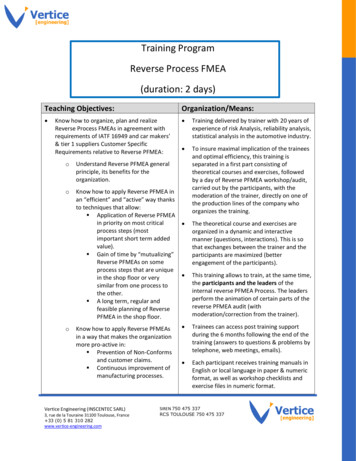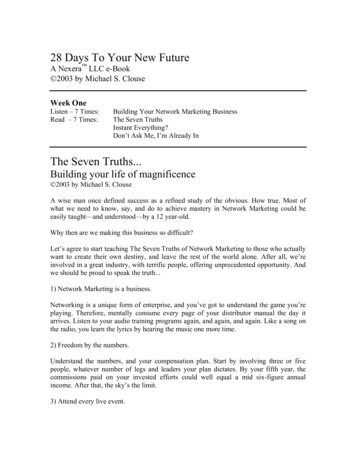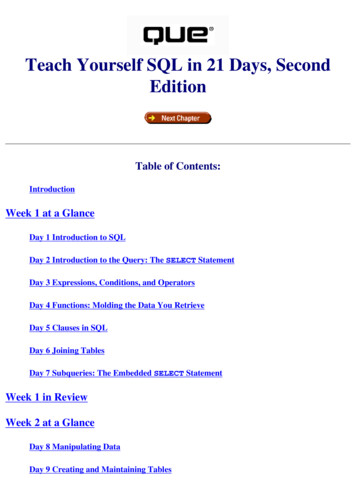
Transcription
Concentrated Knowledge for the Busy Executive www.summary.comVol. 26, No. 4 (2 parts) Part 2, April 2004 Order # 26-10Critical Success Strategies for New LeadersAt All LevelsTHE FIRST90 DAYSTHE SUMMARY IN BRIEFBy Michael WatkinsCONTENTSPromote YourselfPages 2, 3A New Job RequiresA New ApproachPage 2Accelerate Your LearningPage 3Match Strategy to SituationPages 3, 4Secure Early WinsPages 4, 5Negotiate SuccessPages 5, 6Achieve AlignmentPages 6, 7Build Your TeamPages 7, 8Create CoalitionsPage 8Test Their JudgmentIn The First 90 Days, Harvard Business School professor MichaelWatkins presents a road map for taking charge in your first 90 days in amanagement job. The first days in a new position are critical because smalldifferences in your actions can have a huge impact on long-term results.Leaders at all levels are very vulnerable in their first few months in anew job because they lack in-depth knowledge of the challenges they’ll faceand what it will take to succeed with their new company. Failure to createmomentum in the first 90 days virtually guarantees an uphill battle for therest of an executive’s tenure.The First 90 Days will equip you with strategies and tools to get up tospeed faster and achieve more sooner. This summary will show you how todiagnose your situation and understand its challenges and opportunities.You’ll also learn how to assess your own strengths and weaknesses, how toquickly establish priorities, and how to manage key relationships that willhelp you succeed.What You’ll Learn In This Summary How to promote yourself. Successful executives put the past behindthem and get a running start by learning all they can about their new job. How to learn your new role faster. A leader must customize his or herapproach by quickly learning about the organization’s culture and politics. How to choose the right strategy. Selecting the best strategy for yourcompany requires carefully diagnosing the business situation. Only afteryou’ve analyzed the situation can you choose the right strategic plan that willget results. How to make good things happen right away. You want your boss,peers and subordinates to feel that something new and good is happening.Early “wins” excite and energize people and build your credibility. How to build a winning team. Without a great team, you’ll face severedifficulties because no leader can achieve ambitious goals on his or her own.Page 8Published by Soundview Executive Book Summaries, P.O. Box 1053, Concordville, Pennsylvania 19331 USA 2004 Soundview Executive Book Summaries All rights reserved. Reproduction in whole or part is prohibited.FILE: SUCCESS/CAREERTECHNIQUES
THE FIRST 90 DAYSby Michael Watkins— THE COMPLETE SUMMARYPromote Yourselfwalls come crashing down around you.“Promoting yourself” doesn’t mean self-servingbehavior, grandstanding or hiring a PR firm to tell theworld about you. It means mentally preparing yourselfto move into your new role by putting the past behindyou and getting a running start by working hard to learnall you can about your new position.This takes a lot of effort, but it’s essential that you doit. Many promising managers get promoted but don’t doenough to change their perspective and successfullypromote themselves.A similar mistake is to believe that you’ll succeed inyour new job by doing the same things you did in yourprevious job, only at a higher level of authority. “Theyput me in this new job because of my skills and accomplishments,” the reasoning goes, “so that must be whatthey expect me to do here.” Doing what you know andavoiding what you don’t know can seem to work, butthere’s a chance you’ll keep on believing this until theEstablish a Clear BreakpointA New Job RequiresA New ApproachDouglas Ivester was promoted to CEO at CocaCola in 1997 after working as Chief Financial Officerand Chief Operating Officer at the company. In 1999,after a series of blunders that eroded the confidenceof Coke’s Board of Directors, Ivester resigned.To outside observers, Ivester appeared to be theperfect candidate for the job. An accountant by training, Ivester was unable to make the leap from COOto CEO because his extraordinary attention to detail,which had been a virtue in his previous jobs infinance and operations, proved to be a hindrance inhis new position. Ivester could not free himself fromday-to-day operations enough to take on the strategic, visionary roles of an effective CEO.The cause of Ivester’s failure wasn’t what hecouldn’t do, but what he couldn’t let go of. Animpressive career came to a deeply disappointingconclusion because he persisted in focusing on whathe felt most competent doing instead of focusing onwhat the CEO position required.The move from one position to another usually happens so quickly it’s all a blur. A worker rarely getsmuch notice before being thrust into a new job. Thelucky new leader sometimes gets a couple of weeks tomake the change, but more often the move happens inonly a few days.Because you might not get a smooth transition fromone set of job responsibilities to another, it’s essential todiscipline yourself to make a smooth transition mentally. Pick a specific time, maybe a weekend, and use it topicture yourself being promoted. Consciously createmental images of letting go of the old job and embracing the new one. Think hard about the differencesbetween the two positions and how you’ll have to thinkand act differently in the new job. Take time to celebratethe move, even informally with family and friends.Touch base with your advisers to ask for some quickadvice. The bottom line: Do whatever it takes to get intoa transition state of mind.Hit the Ground RunningYour transition begins the moment you learn you’rebeing considered for a new position, and it ends about90 days after you begin the job. At the 90-day mark, keypeople in the organization — your bosses, peers anddirect reports — expect you to be making an impact.(continued on page 3)The author: Michael Watkins is an associate professorof business administration at Harvard Business School.He is the author of Breakthrough Business Negotiation: AToolbox for Managers, the coauthor of Right From theStart: Taking Charge in a New Leadership Role, and theauthor of Leadership Transitions.Book Copyright 2003 by Michael Watkins.Summarized by permission of the publisher, HarvardBusiness School Publishing, 60 Harvard Way, Boston, MA02163. 253 pages. 24.95. ISBN 1-59139-110-5.Summary Copyright 2004 by Soundview ExecutiveBook Summaries. www.summary.com, 800-521-1227,610-558-9495.For Additional Information on the author, go to:http://my.summary.comPublished by Soundview Executive Book Summaries (ISSN 0747-2196), P.O. Box 1053, Concordville, PA 19331USA, a division of Concentrated Knowledge Corporation. Published monthly. Subscriptions: 195 per year in U.S.,Canada & Mexico, and 275 to all other countries. Periodicals postage paid at Concordville, PA and additional offices.Postmaster: Send address changes to Soundview, P.O. Box 1053, Concordville, PA 19331. Copyright 2004 bySoundview Executive Book Summaries.Available formats: Summaries are available in print, audio and electronic formats. To subscribe, call us at1-800-521-1227 (1-610-558-9495 outside U.S. & Canada), or order on the Internet at www.summary.com.Multiple-subscription discounts and Corporate Site Licenses are also available.2Soundview Executive Book Summaries SoundviewExecutive Book Summaries KEVIN GAULT – Senior Contributing EditorDEBRA A. DEPRINZIO – Art and DesignCHRIS LAUER – Managing EditorCHRISTOPHER G. MURRAY – Editor in ChiefGEORGE Y. CLEMENT – Publisher
The First 90 Days — SUMMARYPromote Yourself(continued from page 2)The three-month time frame isn’t written in stone —the time depends on the type of situation you’re in. Butfor planning purposes, you should use the 90-day markas an important milestone. It will help you realize thatyou’ve got to get things done in that short time frame. Ifyou’re fortunate, you may get a month or more betweenthe time you learn you’re being considered and yourfirst day on the new job. Use that time to educate yourself about your organization.Assess Your VulnerabilitiesYou’ve been offered your new position because thepeople who hired you think you’ve got what it takes tosucceed. You probably do. But it can be disastrous torely too much on the skills and knowledge that madeyou successful in the past.One way to focus on your vulnerabilities is to evaluate your problem preferences — the types of problemsthat you prefer to work on. Everyone likes doing somethings more than others, but doing so is like exercisingyour right arm and ignoring your left — the strong armgets stronger and the weak one atrophies. Creating thistype of imbalance leaves you vulnerable in situationsthat call on you to be “ambidextrous.”You can do a lot to overcome your vulnerabilities,including developing self-discipline, team building andgetting advice and counsel. You’ll have to force yourselfto devote time to important activities that you don’tenjoy and that might not come naturally. In addition,you must find people in your organization who are skillful in these areas and learn from them.As you advance in your career, there will be changesin the advice and counsel you require. With promotionscomes the need to get good “political” counsel — experienced corporate advisers can help you understand thepolitics of the organization, which is especially important when you plan to implement change. Accelerate Your LearningUsually when a new leader swerves off course, failureto learn is a factor. There is so much new information toabsorb that it’s difficult to know where to focus andimportant signals can be missed. Or when a new bossfocuses too heavily on the technological side of thebusiness — products, customers, technologies andstrategies — critical learning about culture and politicsis shortchanged.The fact that few managers have received training insystematically diagnosing an organization compoundsthe problem. Those who have had such training are usu-ally human resource professionals or former management consultants.Even in situations in which a leader has been broughtin solely to impart new ways of doing things — such ascorporate turnarounds — the leader still has to customize his or her approach by learning about the organization’s culture and politics.Defining Your Learning AgendaThe starting point is to define your learning agenda,ideally before you even formally enter the organization.A learning agenda establishes your learning prioritiesand consists of a focused set of questions that will guideyour inquiry. As you learn more, you’ll make conclusions about what is going on and why. Your learningwill begin to shift toward fleshing out and testing thoseconclusions.During your transition, you’ll learn from various typesof hard data (e.g., financial and operating reports, strategic and functional plans, employee surveys, pressaccounts, and industry reports). But to make effectivedecisions, you’ll also need “soft” information about theorganization’s strategy, technical capabilities, cultureand politics. The only way to obtain this intelligence isto talk to people who know about your situation.Identifying promising sources will make your learningmore complete and more efficient.Adopting Structured Learning MethodsOnce you have an idea of what you need to learn andwhere to seek it, the next step is to understand the bestway to learn.When diagnosing a new organization, start by meetingwith your direct reports one-on-one and ask them thesefive questions:1. What are the biggest challenges the organizationis facing (or will face) in the near future?2. Why is the organization facing (or going to face)these challenges?3. What are the most promising unexploited opportunities for growth?4. What would need to happen for the organizationto exploit the potential of these opportunities?5. If you were me, what would you focus on? Match Strategy to SituationFar too many new leaders don’t effectively diagnosetheir situations and tailor their strategies accordingly.Then, because they don’t understand the situation, theymake unnecessary mistakes. This painful cycle happensbecause people usually model their transitions on a limited set of experiences.Soundview Executive Book Summaries (continued on page 4)3
The First 90 Days — SUMMARYMatch Strategy to Situation(continued from page 2)Matching your strategy to your situation requiresdiagnosing the business situation carefully. Only afteryou’ve diagnosed the situation can you act wisely aboutthe challenges of your new job and the opportunitiesand resources available to you.Diagnosing the Business SituationThe four broad types of business situations that newleaders must contend with are start-up, turnaround,realignment, and sustaining success (STARS). These arethe defining features of each of the STARS situations:1. Start-up. In a start-up, you’ve got to assemble thecapabilities (people, funding and technology) needed toget a new business, product or project off the ground.2. Turnaround. In a turnaround, you take on a unit orgroup that is in trouble and work to get it back on track.Both start-ups and turnarounds involve a lot of resourceintensive construction work — there isn’t much existinginfrastructure and capacity for you to build on. To a significant degree, you get to start fresh, but both requirethat you start making tough calls early.3. Realignments. Your challenge is to revitalize aunit, product, process or project that is drifting intotrouble. This requires that you reinvent the business.4. Sustaining success. In a sustaining-success situation, you’re responsible for preserving the vitality of asuccessful organization and taking it to the next level.Keep people motivated by inventing a new challenge.Understanding the HistoryAn important point is that businesses (as well as projects, processes, products and plants) tend to move pre-The STARS SucceedGrowth CycleSucceedStart-upFocusing Your EnergyClearly understanding the type of situation you’re inhelps you decide what you must do in your first 90days. Such clarity helps you make three early choices:1. How much emphasis will you place on learningas opposed to doing?2. How much emphasis will you place on offense asopposed to defense?3. What should you do to get some early wins? Secure Early WinsTurnaroundSucceeddictably from one type of situation to another.Understanding the history of your new organization willhelp you manage challenges and opportunities.If start-ups grow, they eventually become sustainingsuccess situations. Those who managed the start-up maymove on to guide new start-ups while managers who aremore experienced at running larger businesses take over.This is how healthy companies enter a growth cycle.Realigning an organization usually means redirectingits resources by abandoning aging product lines anddeveloping new technologies. It can also mean changingthe organization’s strategy, structure, skills and even itsbasic corporate culture.Participants in a start-up are usually more excited andhopeful than workers in a troubled company in need ofa turnaround. But the employees in a start-up are typically much less focused on key issues than those in atroubled organization simply because the start-up stilllacks vision, strategy and structures.Therefore, a large part of successful transitioningdepends on your ability to transform the prevailingorganizational psychology. In start-ups, where the prevailing mood is often one of excited confusion, your jobis to channel that energy into productivity. In turnarounds, you may be dealing with a group of peoplewho are close to despair — it is your job to provide alight at the end of the tunnel.By the end of your transition, you want your boss,your peers and your subordinates to feel that somethingnew and good is happening. Early wins excite and energize people, build your credibility, and quickly createvalue for your organization.It’s crucial to get early wins, but it is also important toget them the right way. These are the most commontraps that afflict new leaders: Failing to focus. It’s very easy to take on too muchduring a transition, and the results can be disastrous.You can’t hope to achieve results in more than a fewareas. It’s essential to identify promising opportunities(continued on page 5)4Soundview Executive Book Summaries
The First 90 Days — SUMMARYSecure Early Wins(continued from page 4)and then focus on translating them into wins. Not taking the business situation into account.What constitutes an early win will differ drasticallyfrom one business situation to another. Simply gettingpeople to talk about the organization and its challengescan be an important accomplishment in a realignment. Not adjusting to the corporate culture. Leaderswho come into an organization from the outside can fallinto this trap. After absorbing a different organization’sculture, they bring with them its view of what a win isand how it is achieved. Be sure you understand whatyour new organization does and does not view as a win. Failing to get wins that matter to your boss. It’sessential to get early wins that energize your employees,but your boss’s opinion about your accomplishments isvery important, too. Even if you don’t fully endorse hisor her priorities, you must keep them in mind as youdecide what early wins to pursue. Letting your means undermine your ends.Process matters. If you achieve impressive results in away that colleagues think is manipulative, underhandedor inconsistent with the corporate culture, you’re askingfor trouble. An early win accomplished in a way thatillustrates the behavior you hope to instill in your neworganization is a double win.build personal credibility. Since your earliest actionswill have a huge influence on how you’re perceived,think about how you’ll get “connected” to your neworganization. What messages do you want to get acrossabout who you are and what you represent? What arethe best ways to convey those messages? Negotiate SuccessNegotiating success means engaging with your newboss to shape the game so you have a good chance ofachieving your goals. Too many new leaders just playthe game, reacting to the situation that exists and failingas a result. Negotiate with your boss to establish realistic expectations, reach agreement on the situation, andsecure sufficient resources to get things done.Focusing on the FundamentalsIn the first 90 days, a key goal is to build personalcredibility and create organizational momentum. Securesome early wins to leverage your energy and expand thepotential scope of your subsequent actions.As you look for ways to create momentum, keep inmind that the actions you take to get early wins shoulddo double duty. Your efforts should:1. Be consistent with A-item business priorities.2. Introduce the new patterns of behavior youwant to instill in your organization.Armed with an understanding of your A-item priorities and objectives for behavior change, you can nowcreate detailed plans for how you’ll secure early winsduring your first 90 days and beyond. You should thinkabout what you must do in two phases: building credibility in the first 30 days and deciding where you’llfocus your efforts to achieve improvements in performance in the following 60 days.When experienced managers are asked about building aproductive relationship with a new boss, their observationsusually consist of do’s and don’ts. Here are six don’ts: Don’t trash the past. There is nothing to be gainedand much to be lost by criticizing the people who ledthe organization before you arrived. You must understand the past but concentrate on assessing currentbehavior and results. Don’t stay away. If you have a boss who doesn’treach out to you, or if your relationship with your bossis uncomfortable, you’ll have to reach out yourself.Otherwise, the quality of communications could be permanently damaged. Don’t surprise your boss. It’s no fun bringing badnews to your boss. The danger that the messenger (you)will be shot is real, but most bosses consider it a greatersin not to report emerging problems early enough. Don’t approach your boss only with problems.You don’t want to be perceived as bringing nothing butproblems for your boss to solve. Give just a few minutes’ thought to how to address the problem, your rolein solving it, and the help you’ll need. Don’t run down your checklist. Even senior managers tend to use meetings with the boss as opportunities to run through their checklist of things they’ve beendoing. There are times when this is appropriate, but it’srarely what your boss needs or wants to hear. Don’t try to change the boss. Assume that you’renot going to change your boss, and adapt to his or herstyle and idiosyncrasies.Building CredibilityBetter Ways to NegotiateYou can’t hope to have a measurable impact on performance in the first few weeks in your new job, butyou can score small victories and show colleagues thatthings are changing. Your objective at this stage is toThere are fundamental do’s on this topic as well. Ifyou follow them, life with your new boss will be easier. Take 100 percent responsibility for making theEstablishing Long-Term GoalsSoundview Executive Book Summaries (continued on page 6)5
The First 90 Days — SUMMARYNegotiate SuccessNegotiating for Resources(continued from page 5)relationship work. Don’t expect your boss to reach outor offer the time and support you need. Assume that it’syour responsibility to make the relationship work. Clarify mutual expectations early and often.Begin managing expectations right away. It’s smart totalk openly about bad news in the beginning and tolower unrealistic expectations. Negotiate time lines for diagnosis and actionplanning. Don’t let yourself get caught up immediatelyin putting out fires or trying to make decisions beforeyou’re ready. Buy yourself some time to diagnose thenew organization and come up with an action plan. Aim for early wins in areas that are important tothe boss. Figure out what the boss cares about most.Once you know, aim for early results in those areas. Inpart, your job is to shape your boss’s perceptions ofwhat can and should be achieved. Try to get good grades from those whose opinions your boss respects. Your new boss’s opinion ofyou will be based partly on your direct interactions andpartly on what he or she hears about you from trustedcolleagues. Your boss may have relationships with people who are now your subordinates. Be aware of themany channels through which information about youand your performance will reach your boss. For Additional Information on not changing the boss, go to:http://my.summary.comAchieve AlignmentThe higher you climb in an organization, the moreyou assume the role of organizational architect, creatingan environment in which others can perform well. Nomatter how charismatic you are, you can’t hope to domuch if key elements in your unit are out of alignment.If strategy, structure, systems and skills are withinyour purview in your new position, you need to begin toanalyze the architecture of your organization and assessalignment among these key elements. You can’t hope todo much more than conduct a solid diagnosis and perhaps get started on addressing alignment issues in thefirst few months. But plans to assess the architecture ofyour group and to begin identifying areas for improvement should be included in your 90-day plan.Designing Organizational ArchitectureBegin by thinking of yourself as an architect of yourunit or group. This may be a familiar role for you, but itprobably isn’t. Few managers get systematic training inorganizational design. Because managers typically have6As you look for commitments for resources, keepthese principles of effective negotiation in mind: Focus on underlying interests. Probe asdeeply as possible to learn the agendas of your bossand any others you’re trying to get resources fromand consider what’s in it for them. Look for mutually beneficial exchanges. Seekresources that support your boss’s agenda andadvance your own. Look for ways to help peersadvance their agendas in return for help with yours. Link resources to results. Emphasize the waysyour team’s performance will improve if moreresources are dedicated to your group. Create a“menu” that lays out what you can achieve with current resources and why you need more.limited control over organizational design early in theircareers, they learn little about it. It is common for lesssenior people to complain about misalignments and towonder aloud why “those idiots” higher up let obviously dysfunctional arrangements continue. By the timeyou reach the mid-senior levels of most organizations,however, you are well on your way to becoming one ofthose idiots. You are well advised to learn somethingabout how to assess and design organizations.To equip your group to achieve its goals, these five elements of organizational architecture must work together:1. Strategy: The core approach the organization willuse to accomplish its goals.2. Structure: How people are grouped in units andhow their work is coordinated.3. Systems: The processes used to add value.4. Skills: The capabilities of the various groups ofpeople in the organization.5. Culture: The values, norms and assumptions thatshape behavior.Identifying MisalignmentsOrganizations can become misaligned in many ways.One important goal during your first 90 days should beto identify possible misalignments and design a plan tocorrect them. Common types of misalignment include: Skills and strategy misalignment. Let’s say youhead an R&D group and your goal is to increase thenumber of new product ideas your team generates. Ifyour group doesn’t understand the latest techniques andsupport tools that would help you perform experimentsfaster, your group’s skills don’t support its strategy. Systems and strategy misalignment. Imagineyou’re the leader of a marketing group whose strategy isSoundview Executive Book Summaries (continued on page 7)
The First 90 Days — SUMMARYAchieve Alignment(continued from page 6)to focus on a new segment of customers. If the grouphasn’t established an effective way to compile and analyze information about those customers, your group’ssystems fail to support its strategy. Structure and systems misalignment. Supposeyou manage a product-development group whose members are organized by product line. This structure letsemployees with specialized expertise focus on specificproducts, but in this case, it has a downside — thegroup doesn’t have systems that compensate for theoverlapping expertise of different product teams.Avoiding Some Common TrapsToo many managers rely on simple fixes to addresscomplicated alignment problems. Be alert to these alltoo-common pitfalls: Trying to restructure your way out of deeperproblems. Resist changing structure until you understand whether restructuring will address the root causesof the problems. Creating structures that are too complex. This isa related trap. Although it may look good on paper tocreate a structure, such as a matrix in which people indifferent units share accountability, too often the resultis bureaucratic paralysis. Automating problem processes. Automating yourgroup’s core processes may yield significant gains inproductivity, quality and reliability, but it’s a mistake tosimply speed up an existing process through technologyif the process has serious underlying problems. Making changes for change’s sake. Resist thetemptation to tear down the fences before you knowwhy they were put up. New leaders who feel selfimposed pressure to put their stamp on the organizationElements of Organizational ultureoften make changes in strategy or structure before theyreally understand the business. Overestimating your group’s capacity to absorbstrategic shifts. It’s difficult for a group to changebecause of large-scale changes in strategy. Focus on afew vital priorities and make changes gradually if timeallows. Build Your TeamIf you create a high-performance team, you can exerttremendous leverage to create value. If not, you’ll facesevere difficulties because no leader can hope to achieveambitious goals on his or her own. Poor personnelchoices will usually come back to haunt you.Finding the right people is essential, but it’s notenough. Begin by evaluating current team members todecide who will stay and who will have to go. Then create a plan for obtaining new people and moving thepeople you keep into the right positions without doingtoo much damage to short-term performance. But eventhis is not enough. You still must establish goals, incentives and performance measures that will propel yourteam in the desired directions.Avoiding Common TrapsWhen it comes to building a winning team, many newleaders stumble. The result may be a delay in reachingthe break-even point, or it may be outright derailment.These are some of the traps new leaders fall into: Keeping the existing team too long. Some leadersclean house too quickly, but it’s more common to keeppeople on board too long. Whether because of pride orbecause they shy away from tough personnel calls,many leaders end up with less-than-outstanding teams.This means they will have to either shoulder more of theload themselves or fall short of their goals. Not repairing the airplane. Unless you’re in astart-up, you don’t get to build a team from scratch: Youinherit a team and have to mold it into what you need toachieve your A-team priorities. Molding a team is likerepairing an airplane in midflight. You will not reachyour destination if you ignore the necessary repairs. Not working organizational alignment and teamrestructuring issues in parallel. You can’t build yourteam before reaching clarity about changes in stra
1-800-521-1227 (1-610-558-9495 outside U.S. & Canada), or order on the Internet at www.summary.com. Multiple-subscription discounts and Corporate Site Licenses are also available. Soundview Executive Book Summaries KEVIN GAULT – Senior Contributing Editor DEBRA A. DEPRINZIO – Art











